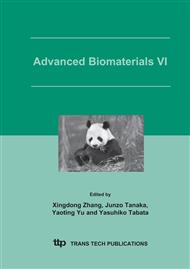p.323
p.327
p.331
p.335
p.339
p.343
p.347
p.351
p.355
Hemocompatibility of PET (Polyethylene Terephthalate) Films Grafted PEG (Polyethylene Glycol) by Plasma Surface Modification
Abstract:
In this paper, polyethylene glycol (PEG) of various different molecular weights was grafted onto PET films using plasma surface grafting modification. The surface structure of PEG-grafted PET films was analyzed by attenuated total reflection Fourier transform infrared spectroscopy (ATR-FTIR) and X-ray photoelectron spectroscopy (XPS), suggesting that the surface structure and composition of PET films changes due to the presence of PEG. Blood compatibility was characterized by in vitro platelet adhesion experiments and coagulation factors. The tests of platelet adhesion and coagulation factors in vitro suggest that PEG grafted onto polymer surfaces can improve the blood compatibility of PET films remarkably. The modified PET films were pre-coated with albumin and fibrinogen respectively; platelet adhesion tests in vitro then indicated that samples pre-coated with albumin have better blood compatibility than with fibrinogen, resulting in the conclusion that the albumin can improve blood compatibility. The contact angle of PEG-grafted films was measured by the sessile drop method and the surface free energy and interface free energy were induced. It is indicated that the PEG-grafted PET films have the characteristic of preferentially adsorbing albumin.
Info:
Periodical:
Pages:
339-342
Citation:
Online since:
June 2005
Authors:
Price:
Сopyright:
© 2005 Trans Tech Publications Ltd. All Rights Reserved
Share:
Citation:


